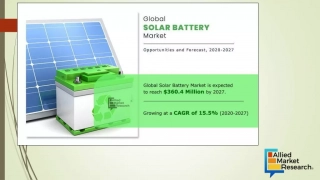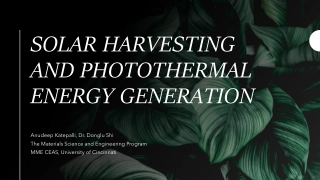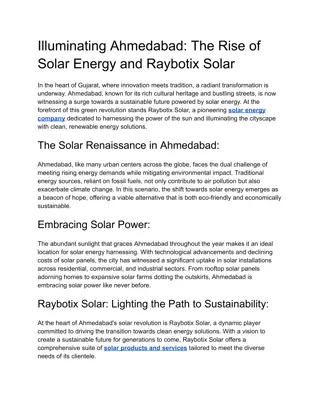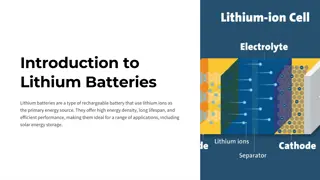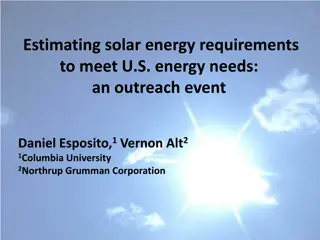
Solar Collectors: Types, Usability, and Benefits Explained
Discover the world of solar collectors, devices that harness solar energy for water heating and electricity generation. Learn about different types, advantages, and how they help cut down energy consumption both at home and on a commercial scale.
Download Presentation

Please find below an Image/Link to download the presentation.
The content on the website is provided AS IS for your information and personal use only. It may not be sold, licensed, or shared on other websites without obtaining consent from the author. If you encounter any issues during the download, it is possible that the publisher has removed the file from their server.
You are allowed to download the files provided on this website for personal or commercial use, subject to the condition that they are used lawfully. All files are the property of their respective owners.
The content on the website is provided AS IS for your information and personal use only. It may not be sold, licensed, or shared on other websites without obtaining consent from the author.
E N D
Presentation Transcript
StudyMafia.Org Solar Collector Submitted To: Submitted By: Studymafia.org Studymafia.org
Content What is Solar Collector? Types Advantages Disadvantages
What is Solar Collector? A solar collector is an object that is used to collect energy from the sun, which it does by absorbing solar radiation and converting it into heat or electricity. The material type and coating on a solar collector are used to maximize solar energy absorption.
Usability of Solar Collectors The solar collector devices serve as an alternative to conventional domestic & commercial water heating. In place of the traditional electricity-operated water heaters, solar collectors are used for heating water via harnessing solar radiation.
These devices help to cut down energy consumption over time. Besides helping for power saving in households, solar collectors also serve well on a commercial scale. Multiple solar collectors are connected as an array to form an interconnected system for producing electrical energy in solar farms or power plants.
Types of Solar Collectors Flat Plate Collectors Evacuated Tube Collectors Line Focus Collectors Point Focus or Parabolic-Dish Collectors
Flat Plate Collectors Flat Plate Collectors are the most simple and common types of solar collectors that anyone can see in their areas. These are basically metal boxes with a dark-coloured absorber plate and have a transparent glazing cover on the top. Such plates are generally fabricated from a metal, such as copper or aluminium, which is a good conductor. For better absorption and retaining of heat, these absorber plates are sometimes painted with special coatings other than the usual black paint.
Heres a brief reference in regard to how these collectors work and what their components are. There s a glazing material used in the flat-plate collectors. The material is transparent and the solar radiation courses down through this material in order to reach the absorbing plate. Once enough radiation hits the absorber plate, it does its job: heating the plate. The entire purpose behind generating and circulating that generated heat between the absorber plate & the glazing cover is to raise the temperature of the water or air that s flowing between the plate and the cover. To diminish heat loss to other parts of the solar collector, the bottom and the sides of the device are covered with insulation.
Evacuated Tube Collectors When talking about Evacuated Tube Solar Collectors, you ll find out that instead of one, there s an entire fleet of evacuated tubes needed to raise the temperature of the water by heating it. Such tubes use an evacuated space or vacuum to trap the energy from the sun. The main application of these tubes is to minimize heat loss. Here s a reference in regard to their components and working: A metal tube plays the part of the absorber plate. The absorber plate is directly patched with a heating pipe. The liquid that has to be heated flows inside the heating pipe. The job of the heating pipe is to show direction to the heat so that it can raise the water s temperature.
Easier said than done: its not that simple to understand how the heat pipe allows the transfer of thermal energy from one point to another. But worry not, we ve simplified things for you. There are naturally two ends in a heating pipe. One end opens at the side of the absorber plate. It s where the heat is generated. Hence, this point is known as the heat end. The second end opens at the side of the cool water that s supposed to be heated. This end is naturally known as the cold end. At a certain pressure, the generated heat starts flowing towards the cold end; eventually, heating the cold water.
Line Focus Collectors Better known as parabolic troughs, the Line Focus Solar Collectors use the same principle for heating water or air that other collectors do: collecting heat on an absorber plate and then transferring it to the water that s to be heated. The collector here is a rather effective parabola-shaped reflective material. The line focus collectors are extremely powerful solar collector types. Therefore, they are used for producing steam for large solar thermal power plants and not for domestic purposes. There is a pipe in the centre of this trough that functions as a carrier of water. The sunlight gathered by the reflective material is focused onto this central pipe which leads to the heating of the water. Notably, the troughs productively produce heat energy from the sunlight, specifically the pivot troughs, which track the sun throughout the day for optimal trapping of sunlight.
Point Focus or Parabolic-Dish Collectors The Point Focus Collectors are also large parabolic-shaped devices that are fabricated with highly reflective material. These types of solar collectors again follow the same concept as that of other collectors: they directly focus all the collected solar energy onto a single point that s usually the absorber plate. The heat generated is so substantial that it is utilised for operating Stirling engines. These parabolic dishes can work as independent installations. For efficient collection, they constantly track the position of the sun. They can very well be used in tandem with concentrated PV modules.
Advantages Helps cut down your electricity bills. Minimises your carbon footprint. Solar collectors do not need any fuels for operation.
Disadvantages High cost of investment. The solar thermal plant requires a large quantity of water, which may be an issue in areas with water scarcity. There are frequent innovations in the solar energy industry, so the technology may become outdated very soon.
Conclusion Solar Collectors are heat exchanging devices that trap sunlight for various heating applications. Different types of solar collectors are available in the market, from the simplest to complicated structures. Based on major influencing factors like required output, ongoing season, & intended applications, you can easily choose one from these available types of solar collectors that are ideal for your requirements.
References Google.com Wikipedia.org Studymafia.org Slidespanda.com
Thanks To StudyMafia.org

